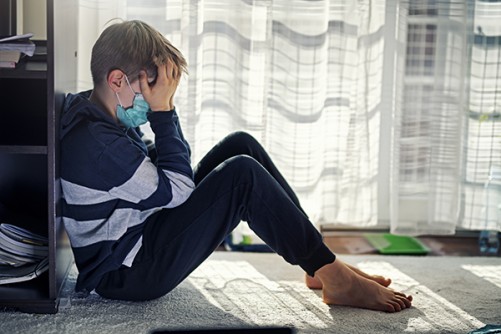In addition to the phsyical health problems caused by the pandemic, there has been a heavy mental health toll from months of lockdown and upheaval – particularly for children and teens.
A recent report published by the Centers for Diease Control and Prevention (CDC) showed that since the pandemic started, mental-health related visits to hospital emergency rooms rose 24% for children ages 5-11, and 31% for children ages 12-17 compared with data from 2019.
“The increase in the proportion of emergency room visits for children’s mental health is due not just to the stress of the pandemic in general, but to the disruption in outpatient mental health services that usually handle these patients’ needs, and an increased reliance on emergency department services for both routine and crisis treatment,” said Lokesh Shahani, MD, MPH, chief medical officer at UTHealth Harris County Psychiatric Center and assistant professor in the Louis A. Faillace, MD, Department of Psychiatry and Behavioral Sciences at McGovern Medical School at UTHealth.
The pandemic’s effect on home and school life are the concerns most often being expressed by children who are visiting mental health professionals.
“A lot of our kids and families are expressing loss of daily routine, particularly around school attendance and bedtime,” said Nicole Bartek, a psychiatric nurse practitioner iwth UTHealth, who said she also sees many kids who are worried about their grades and how this school year will ultimately affect their future.
While the core reason behind the depression or anxiety is the same, it can be expressed in a variety of different ways.
“Watch for behavior changes in your child. Not all children and teens respond to stress in the same way but there are some common changes to watch for,” Shahani said.
Some of those changes include:
Excessive crying and irritability in younger children
A return to behaviors a child has outgrown, like bedwetting
Excessive worry or saddness
Unhealthy or irregular eating or sleeping habits
Irriitability or “acting out” by teenagers
Poor academic performance or avoiding school altogether
Difficulties with attention and concentration
Avoidance of activities enjoyed in the past
Unexplained headaches or body pain
Use of alcohol, tobacco, or other drugs
Social distancing is playing a role in the rise of mental health issues, experts say. Elizabeth Newlin, MD, associate professor and vice chair for child and adolescent psychiatry at McGovern Medical School, explained that social connections provide a vital source of resilience. This prolonged period of social distancing has challenged our ability to capitalize on what is usually our greatest source of strength and resilience – our close relationships with loved ones, friends, and our sense of belonging or that we are grounded in a community. Those who are dealing with underlying vulnerabilities, pre-exisiting conditions, and who were already feeling marginalized before the pandemic have been hit hardest by the additional measures imposed by quarantine and social distancing.
Cristian Zeni, MD, PhD, associate professor of psychiatry at McGovern Medical School said that while social distancing can be difficult, it is important to explain to kids the reasons for it, especially the role it plays in keeping others safe. “Having a conversation about why social distancing practices are in place will help show kids that they are doing this to help everyone, which will boost their self-esteem and citizenship,” he said.
Newlin offered four techniques children and teens can use to keep their stress and anxiety levels in check.
Take breaks from technology.
Limit exposure to media and news about the pandemic and tell a parent or trusted adult if you find the information upsetting.
Experiment with new ways to manage stress to figure out what works best for you. Try unwinding by journaling, going for a walk, or taking a bubble bath.
Exercise, eat healthy, and get adequate sleep.
However, if stress and anxiety become too much to handle with these tools, several resources are available to provide additional help and support, including telemedicine services with mental health professionals at UT Physicians, the clincal practice of McGovern Medical School.
The Texas Child Health Access Through Telemedicine Program (TCHATT) provides short-term telemedicine services by partnering school counselors with providers from UTHealth. The program can also remotely screen and assess referred students for depression or suicide using evidence-based psychological measures.
“Our multidisciplinary team is made up o social workers, psychologists, mental health nurse practitioners, and child psychiatrists, who work together to provide a rapid assessment, triage, stabilization, and connection to community-based providers. The team works to assess the student and collect needed information from the referring school counselor and family members to better understand the social context and events that precipitated the crisis,” Newlin said.
Newlin, who leads TCHATT for UTHealth, said it is currently utilized by eight school districts and three charter school systems serving over 300,000 students in Harris, Fort Bend, and Waller counties.








